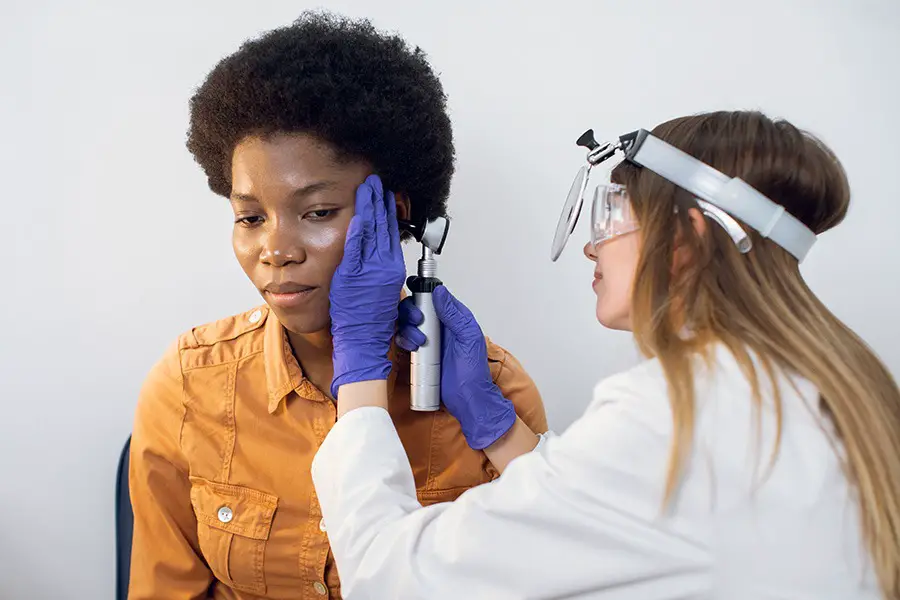Introduction
Listening is a vital connection to the world around us, enhancing our life’s interactions. However, sensorineural hearing loss, a prevalent hearing disorder, presents considerable challenges for millions of adults globally. Examining its evolution, its research, and the advancements in its treatment can empower those affected by this condition and their caregivers. This timeless post delves into the intriguing story of sensorineural hearing loss, highlighting historical treatment methods, significant milestones, and the substantial progress in research.
OTC Hearing Aid Pair
Experience the world like never before with the RCA OTC Behind-the-Ear Hearing Aid. Our advanced digital technology ensures that every sound is crystal clear and vibrant, allowing you to fully immerse yourself in life’s experiences. Whether it’s the laughter of loved ones or the music that moves you, our hearing aid brings back the joy of every moment.
Say goodbye to the hassle of appointments and prescriptions. The RCA OTC Hearing Aid is designed to meet the needs of individuals without the need for a prescription. With its seamless setup and user-friendly design, you can effortlessly enhance your hearing abilities and stay connected to the world around you. Simply unpack, wear, and enjoy improved auditory perception instantly.
Experience optimal comfort and style with our discreet behind-the-ear design. The thin tube design allows you to wear glasses comfortably, so you can enjoy clear hearing while maintaining your personal sense of style. Plus, our rechargeable battery ensures long-lasting power, eliminating the inconvenience of constantly replacing small batteries. Elevate your hearing experience with the RCA OTC Hearing Aid and embrace the world with confidence.
Tracing the Path of Sensorineural Hearing Loss: A Synopsis
Sensorineural hearing loss, resulting from harm to the inner ear or the auditory nerve, has been identified as a health concern for centuries. The earliest instances can be traced back to Ancient Egypt, where primitive medical scripts described symptoms remarkably similar to present-day sensorineural hearing loss. As medical knowledge progressed, the understanding of this condition has enhanced, and its characterization has become more precise.
In the 19th and early 20th centuries, the emerging field of audiology started to understand the intricacy of sensorineural hearing loss. Anatomical studies of the human ear and experiments with primitive hearing devices highlighted the inner ear and auditory nerve’s role in sound processing. This insight served as the foundation for future advancements in diagnosis and treatment.
Sensorineural Hearing Loss Research: An Evolutionary Perspective
The study of sensorineural hearing loss has seen dramatic transformations over the last century. The advent of contemporary medical technologies and methodologies allowed scientists to investigate the human auditory system’s biological intricacies. The revelation of the cochlea’s role in the functioning of the inner ear was a game-changing moment in understanding the mechanics of sensorineural hearing loss.
Over the recent decades, research has broadened to include genetic factors beyond the biological aspects of sensorineural hearing loss. Scientists have discovered that specific gene mutations could predispose individuals to this condition. The ongoing advancements in DNA sequencing and genetic engineering hold the potential for future breakthroughs in our understanding and management of sensorineural hearing loss.
Tinnitus: The Truth Behind That Annoying Ringing in Your Ears
Sensorineural Hearing Loss: Historical Remedies Between Reality and Myth
Historically, the treatments for sensorineural hearing loss were largely based on conjecture and folklore rather than scientific proof. Practices like using medicinal herbs or ear candling were widespread, despite their demonstrated ineffectiveness. Some societies even attributed hearing loss to supernatural forces, prescribing rituals or spells as remedies.
Thankfully, the advancement of scientific knowledge has cleared misconceptions about sensorineural hearing loss, leading to the debunking of these non-evidence-based practices. Today, we understand that these remedies lack effectiveness and that modern medical interventions, guided by solid research and clinical trials, offer the best hope for managing this condition.
Tinnitus: why it’s still such a mystery to science
Pivotal Developments in Sensorineural Hearing Loss Treatment: From Ear Trumpets to Cochlear Implants
The treatment arena for sensorineural hearing loss has seen several turning points that have drastically improved the lives of those affected. In the past, people used ear trumpets – large horn-like devices that collected sound and directed it into the ear. While these devices could intensify sound, they were cumbersome and could not address sensorineural hearing loss’s intricacies.
The introduction of electronic hearing aids in the 20th century marked a significant advancement. These devices, which have continually improved in sophistication and miniaturization over the decades, amplify sound to assist individuals with sensorineural hearing loss. However, the most revolutionary development was the invention of the cochlear implant in the 1960s. These implants bypass the damaged parts of the auditory system to stimulate the auditory nerve directly, providing a new form of auditory perception to individuals with severe to profound sensorineural hearing loss.
Further advancements include bone-anchored hearing systems and middle ear implants, offering additional options to suit the diverse needs of those with sensorineural hearing loss. Currently, personalized treatments are possible, allowing for solutions tailored to an individual’s unique hearing profile.
QUIZ - AVAILABLE TREATMENTS FOR TINNITUS
From Quietude to Audible: The Advancement of Sensorineural Hearing Loss Research
The progress in sensorineural hearing loss research has provided hope and improved the quality of life for countless individuals. From a time when the condition was poorly understood, we’ve arrived at a stage where sophisticated interventions and assistive technologies are accessible to many.
Contemporary research efforts increasingly concentrate on prevention, restoration, and cure. Pioneering work in gene therapy, stem cells, and regenerative medicine offers the tantalizing potential of restoring natural hearing. As our understanding of the complex genetics and biology of sensorineural hearing loss deepens, the future of treatment seems promising.
Conclusion
Tracing the path from basic early treatments to today’s sophisticated interventions, the transformation has been astounding. The advancement of sensorineural hearing loss research has changed lives, replacing silence with sound and enhancing communication.
Every debunked historical remedy, every treatment milestone, and the ongoing research underscore the human endeavor to understand, innovate, and improve. There is still much to learn, but with the rate of progress in today’s scientific and medical fields, we can be hopeful for a future where sensorineural hearing loss can be even more effectively managed, or even possibly cured.
Looking ahead, we can expect continuous advancements in technology, genetics, and medical treatments. The persistent progress in research and innovation holds the promise of a future where sensorineural hearing loss doesn’t signify silence, but an opportunity to connect with the world in unique ways. It’s a journey of understanding, growth, and above all, hope.

Decoding Silence: An Analytical View on the Advances in Conductive Hearing Loss Research and Treatment
This analytical article sheds light on conductive hearing loss, offering an in-depth exploration of its genetic factors, treatment advances, and promising experimental therapies.

Embracing the Melody of Life: Navigating the Journey with Conductive Hearing Loss
A blog post delving into the experiences and challenges of living with conductive hearing loss, discussing its impact on everyday life, social interactions, mental health, and the potential benefits of hearing aids and cochlear implants.





